PHP Tutorial Laravel 4 Framework (Authentication) - Creating User Account III

Laravel 4
- Installing on Ubuntu - local
- Installing on a Shared host
- Installing on Windows
- Creating users table
- Home page with controller and blade
- Blade Templating
- Database connection and sending emails
- Creating user account I - GET
- Creating user account II - POST
- Creating user account III - Error checking & redirecting input
- Creating user account IV - User::create()
- Activating user account I - Mail::send()
- Activating user account II - Update user's status
- User account sign-in I - Route and link
- User account sign-in II - Validation
- User account sign-in III - Login Authentication
- Singing out
- Remember the user
- Changing Password I
- Changing Password II
- Recovering forgotten password I
- Recovering forgotten password II
- User Profile
- Database Migration using artisan
This tutorial is the continuation from Creating user account II - POST.
We want to have more fields related to the account creation. So, let's modify create.blade.php:
@extends('layout.main')
@section('content')
<form action="{{ URL::route('account-create-post') }}" method="post">
<div class="field">
Email: <input type="text" name="email">
</div>
<div class="field">
Username: <input type="text" name="username">
</div>
<div class="field">
Password: <input type="password" name="password">
</div>
<div class="field">
Password again: <input type="password" name="password_again">
</div>
<input type="submit" value="Create account">
{{ Form::token() }}
</form>
@stop
Let's see what's been changed when we hit the uri:
If we hit the root:
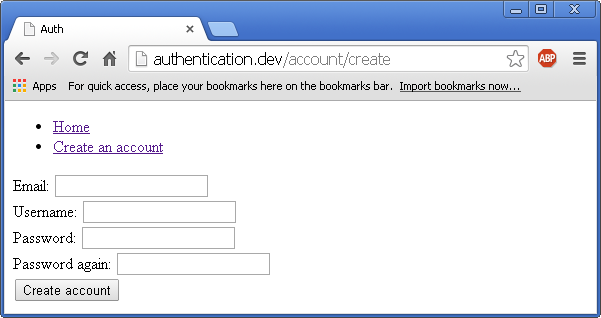
Now that we have forms, it's time to add functionality to those forms as well as validation and error handling.
Let's open AccountController.php and so a test:
public function postCreate() {
print_r(Input::all());
}
When we hit "Create account", it returns an array like this:
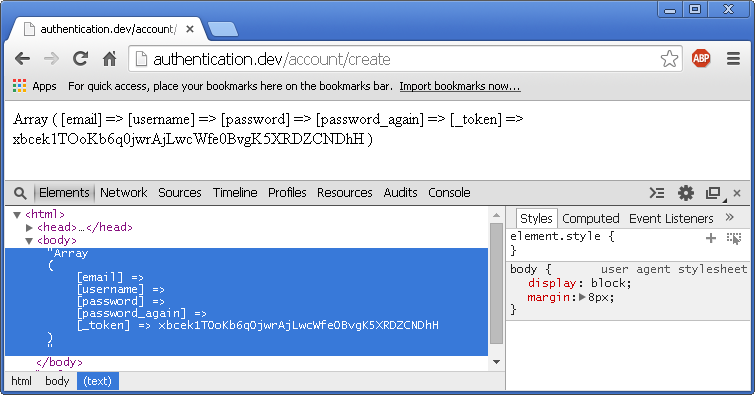
Using the Input::all(), we can put validator:
<?php
class AccountController extends BaseController {
/* Viewing the form */
public function getCreate() {
return View::make('account.create');
}
/* Submitting the form */
public function postCreate() {
$validator = Validator::make(Input::all(),
array(
'email' => 'required|max:50|email|unique:users',
'username' => 'required|max:20|min:3|unique:users',
'password' => 'required|min:6',
'password_again'=> 'required|same:password'
)
);
if($validator->fails()) {
return Redirect::route('account-create')
->withErrors($validator)
->withInput(); // redirect with inputs
} else {
// create an account
}
}
}
We need to add error output to create.blade.php:
@extends('layout.main')
@section('content')
<pre>{{ print_r($errors) }}</pre>
<form action="{{ URL::route('account-create-post') }}" method="post">
<div class="field">
Email: <input type="text" name="email">
</div>
<div class="field">
Username: <input type="text" name="username">
</div>
<div class="field">
Password: <input type="password" name="password">
</div>
<div class="field">
Password again: <input type="password" name="password_again">
</div>
<input type="submit" value="Create account">
{{ Form::token() }}
</form>
@stop
If we click the "Create account" button without filling any data or wrong format, we get the following on our page:
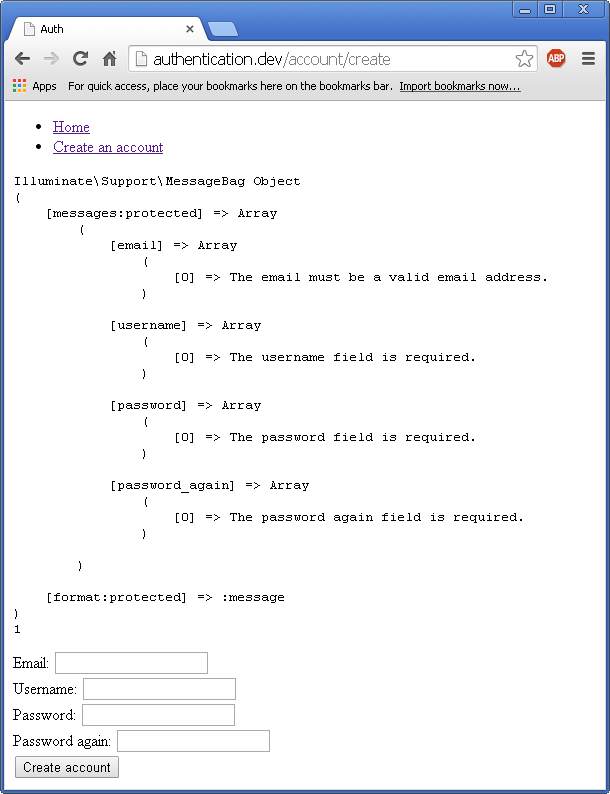
Obviously, that kind of error messages are not desirable since it's not user friendly. So, we need to handle each error for each field.
<div class="field">
Email: <input type="text" name="email">
@if($errors->has('email'))
{{ $errors->first('email')}}
@endif
</div>
Let's see what changes have been made to the error message if we try to create an account without email input:
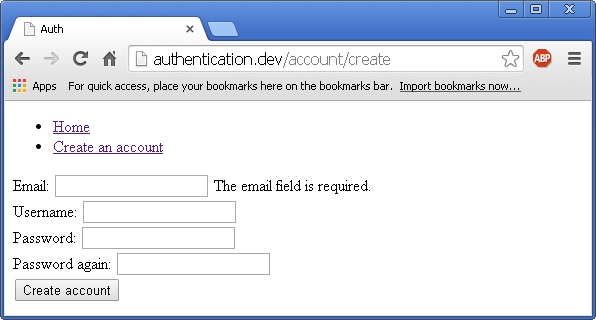
Ii I typed in the email that has been taken, tom@bogotobogo.com:
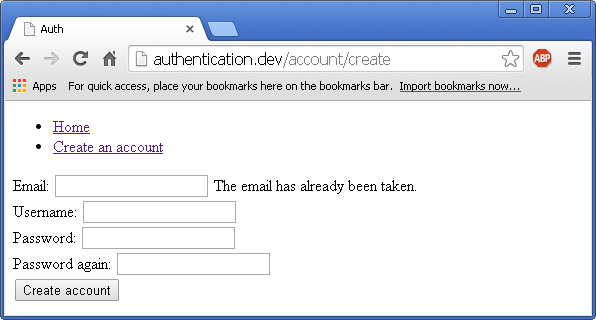
Also, we do not want any valid input disappear and re-type in due to an error. We want to redirect it. Fortunately, there is a way to put the old value back by setting the value attribute to the old one:
<div class="field">
Email: <input type="text" name="email" value="{{ Input::old('email') }}">
@if($errors->has('email'))
{{ $errors->first('email')}}
@endif
</div>
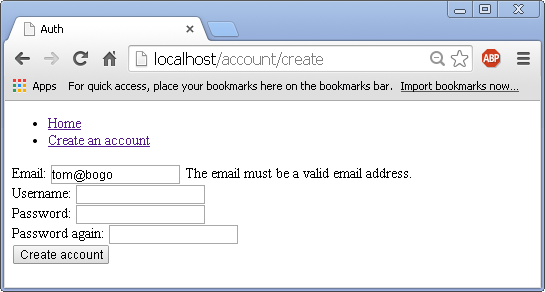
Now, we want to do the same for 'username' as well. Also, error handling should be done to other fields.
@extends('layout.main')
@section('content')
<form action="{{ URL::route('account-create-post') }}" method="post">
<div class="field">
Email: <input type="text" name="email" value="{{ Input::old('email') }}">
@if($errors->has('email'))
{{ $errors->first('email')}}
@endif
</div>
<div class="field">
Username: <input type="text" name="username" value="{{ Input::old('username') }}">
@if($errors->has('username'))
{{ $errors->first('username')}}
@endif
</div>
<div class="field">
Password: <input type="password" name="password">
@if($errors->has('password'))
{{ $errors->first('password')}}
@endif
</div>
<div class="field">
Password again: <input type="password" name="password_again">
@if($errors->has('password_again'))
{{ $errors->first('password_again')}}
@endif
</div>
<input type="submit" value="Create account">
{{ Form::token() }}
</form>
@stop
If submitted with all empty fields:
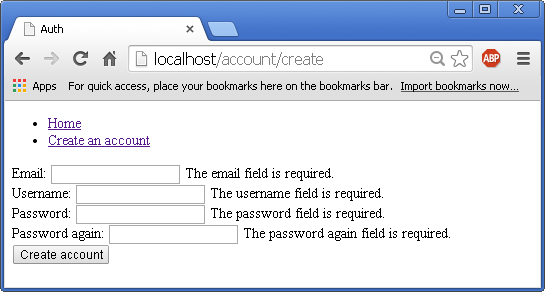
With incorrect email format and username already taken while others are correct:
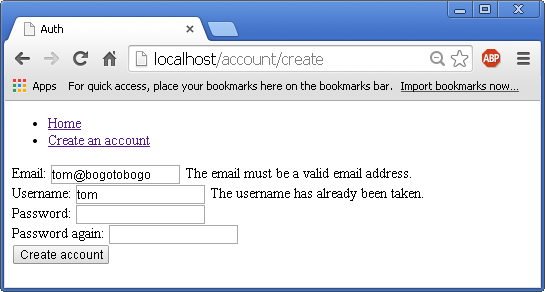
With password pair not matching:
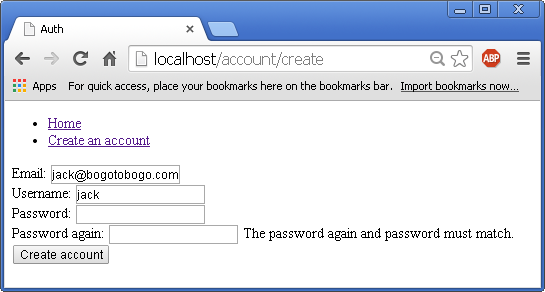
Laravel 4
- Installing on Ubuntu - local
- Installing on a Shared host
- Installing on Windows
- Creating users table
- Home page with controller and blade
- Blade Templating
- Database connection and sending emails
- Creating user account I - GET
- Creating user account II - POST
- Creating user account III - Error checking & redirecting input
- Creating user account IV - User::create()
- Activating user account I - Mail::send()
- Activating user account II - Update user's status
- User account sign-in I - Route and link
- User account sign-in II - Validation
- User account sign-in III - Login Authentication
- Singing out
- Remember the user
- Changing Password I
- Changing Password II
- Recovering forgotten password I
- Recovering forgotten password II
- User Profile
- Database Migration using artisan
Ph.D. / Golden Gate Ave, San Francisco / Seoul National Univ / Carnegie Mellon / UC Berkeley / DevOps / Deep Learning / Visualization